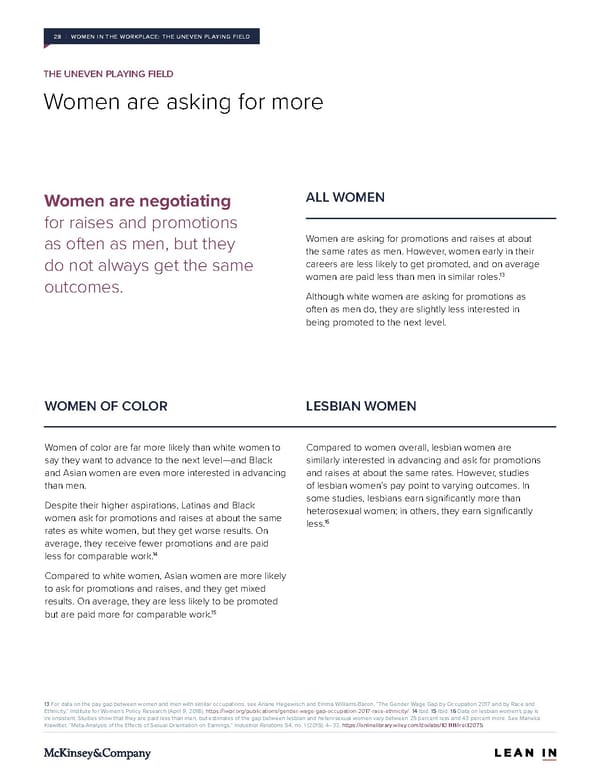28 | WOMEN IN THE WORKPLACE: THE UNEVEN PLAYING FIELD THE UNEVEN PLAYING FIELD Women are asking for more Women are negotiating ALL WOMEN for raises and promotions as often as men, but they Women are asking for promotions and raises at about the same rates as men. However, women early in their do not always get the same careers are less likely to get promoted, and on average 13 outcomes. women are paid less than men in similar roles. Although white women are asking for promotions as often as men do, they are slightly less interested in being promoted to the next level. WOMEN OF COLOR LESBIAN WOMEN Women of color are far more likely than white women to Compared to women overall, lesbian women are say they want to advance to the next level—and Black similarly interested in advancing and ask for promotions and Asian women are even more interested in advancing and raises at about the same rates. However, studies than men. of lesbian women’s pay point to varying outcomes. In Despite their higher aspirations, Latinas and Black some studies, lesbians earn significantly more than women ask for promotions and raises at about the same heterosexual women; in others, they earn significantly 16 rates as white women, but they get worse results. On less. average, they receive fewer promotions and are paid 14 less for comparable work. Compared to white women, Asian women are more likely to ask for promotions and raises, and they get mixed results. On average, they are less likely to be promoted 15 but are paid more for comparable work. 13 For data on the pay gap between women and men with similar occupations, see Ariane Hegewisch and Emma Williams-Baron, “The Gender Wage Gap by Occupation 2017 and by Race and Ethnicity,” Institute for Women’s Policy Research (April 9, 2018), https://iwpr.org/publications/gender-wage-gap-occupation-2017-race-ethnicity/. 14 Ibid. 15 Ibid. 16 Data on lesbian women’s pay is inconsistent. Studies show that they are paid less than men, but estimates of the gap between lesbian and heterosexual women vary between 25 percent less and 43 percent more. See Marieka Klawitter, “Meta-Analysis of the Effects of Sexual Orientation on Earnings,” Industrial Relations 54, no. 1 (2015): 4–32, https://onlinelibrary.wiley.com/doi/abs/10.1111/irel.12075.
 Women in the Workplace Page 33 Page 35
Women in the Workplace Page 33 Page 35